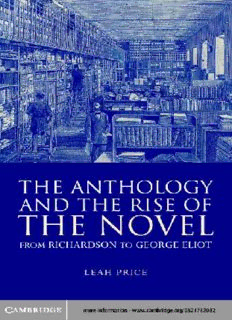
The Anthology and the Rise of the Novel: From Richardson to George Eliot PDF
Preview The Anthology and the Rise of the Novel: From Richardson to George Eliot
This page intentionally left blank XXXXXX THE ANTHOLOGY AND THE RISE OF THE NOVEL FromRichardsontoGeorgeEliot The Anthologyand the Rise of the Novel bringstogethertwo tradition- allyantagonisticfields,bookhistoryandnarrativetheory,tochal- lenge established theories of ‘‘the rise of the novel.’’ Leah Price shows that far from leveling class or gender distinctions, as has longbeenclaimed,thenovelhasconsistentlylocatedthemwithin its own audience. Shedding new light on Richardson and Radcliffe,Scottand GeorgeEliot,this bookasks whytheepistol- arynoveldisappeared,howthebookreviewemerged,whyeight- eenth-century abridgers designed their books for women while Victorianpublishersmarketedthemtomen,andhoweditors’re- production of old texts has shaped authors’ production of new ones.Thisinnovativestudywillchangethewaywethinknotjust about the history of reading, but about the genealogy of the canon wars, the future of intellectual property, and the role that anthologiesplayinourownclassrooms. Leah Price is Professor of English at Harvard University. XXXXXX THE ANTHOLOGY AND THE RISE OF THE NOVEL From Richardson to George Eliot LEAH PRICE HarvardUniversity The Pitt Building, Trumpington Street, Cambridge, United Kingdom The Edinburgh Building, Cambridge CB2 2RU, UK 40 West 20th Street, New York, NY 10011-4211, USA 477 Williamstown Road, Port Melbourne, VIC 3207, Australia Ruiz de Alarcón 13, 28014 Madrid, Spain Dock House, The Waterfront, Cape Town 8001, South Africa http://www.cambridge.org ©Leah Price 2004 First published in printed format 2000 ISBN 0-511-03092-4 eBook (Adobe Reader) ISBN 0-521-78208-2 hardback ISBN 0-521-53939-0 paperback Contents Acknowledgments pagevi Introduction Richardson’seconomiesofscale Writingagainstthemoment Meaningandgaping ‘‘CopyinotherHands’’ Theinvisiblehand Postscript:Scottandtheliterary-historicalnovel Culturesofthecommonplace Knox’sscissor-doings Bowdler’sprivatepublic Radcliffe’suncommonreaders Coda:Ferrier’ssecond-handsentiments GeorgeEliotandtheproductionofconsumers Readingagainsttheplot Womenofmaxims ‘‘Outsidesayingsanddoings’’ Theethicsofthereview Conclusion:‘‘Thebusinessofthenovel’’ Notes Bibliography Index v Acknowledgments Thisstudyofreadersowesalottoitsown.I’mgratefultoRuthYeazell not just for criticizing several drafts in detail, but for her intellectual generosity during the years they were written; to Peter Brooks, who responded thoughtfully to a dissertation that strayed far from his own interests,andtaughtmealotaboutnovel-readingalongtheway;andto Gillian Beer for trenchant comments on the manuscript as well as various forms of institutional support. For close readings of the entire book, I’m indebted to Ann Gaylin, Steve Monte, David Quint, Alex Woloch,andespeciallyMargaretHomans.DavidBromwich,IanDun- can, Stephen Greenblatt, Sarah Meer, James Simpson, Pam Thur- schwell, and Alexander Welsh commented on parts of the project in waysthatmadethewholebetter.Mostofwhatfollowswasarguedout withNatalkaFreeland,whosecriticismhastaughtmealmostasmuchas her friendship. Thanks also to Elizabeth Eger, Ina Ferris, Kate Flint, Dan O’Neill, Jeffrey Robinson, and Ashley Tellis for bibliographical suggestions,toNicolaBown,Cl´ıonaO´Gallchoir,andJanSchrammfor camaraderie,to Roland Greenefor puttingme in a position to under- takethisproject,andtoRichardPriceandSallyPriceforanexampleof common reading very different from the Bowdler family’s. Nor does LindaBreebearany resemblance(apartfromthe amountof timethat she put into the book) to the monomaniacal editors who populate its pages. Back in , Roger Chartier’s seminar at the Ecole des Hautes Etudesen SciencesSociales taught me most of what I know about the history of the book, as well as how much I don’t. I’m grateful to the EcoleNormaleSupe´rieure,HarvardUniversity,andtheMiniste`redes Affaires Etrange`res for funding that year, as well as to the Mellon Foundation, the Beinecke Library, and the Yale Department of Com- parativeLiteraturefor financialsupportsince then. Thanksalsoto the Mistress and Fellows of Girton College, Cambridge for granting the vi Acknowledgments vii ResearchFellowshipduringwhichthemanuscriptwascompleted,and tocolleaguesthereformakingitastimulatingplacetowork.Thisbook couldnothavebeenwrittenwithoutthehelpofstaffattheBibliothe`que deFrance,theBritishLibrary,CambridgeUniversityLibrary,Sterling Memorial Library, the Beinecke Library, and the National Library of Scotland. Partsofthefollowingchaptersreworkmaterialthatappearedearlier in Novel, Studies in Eighteenth-Century Culture, Women’s Writing, and Eight- eenth-Century Fiction; I’m grateful to those journals for permission to reprint. XXXXXX
